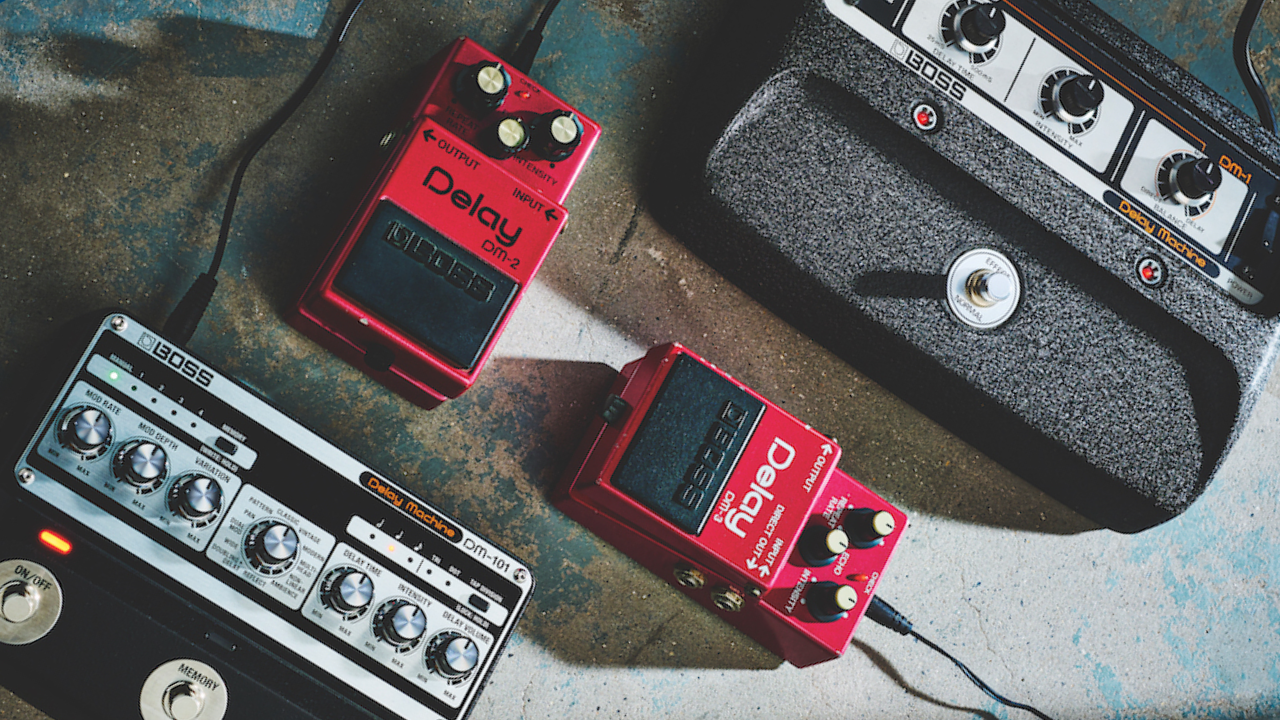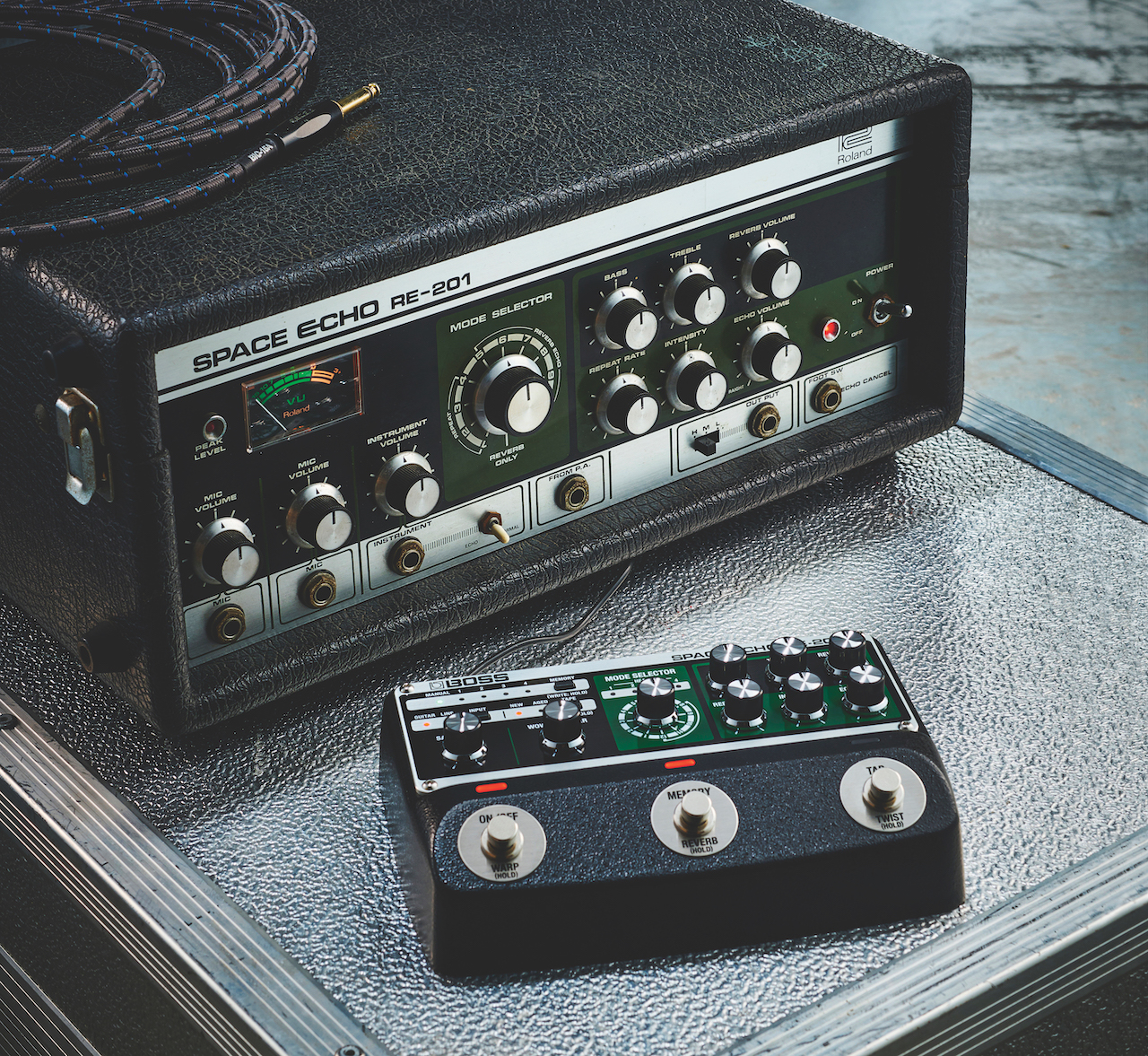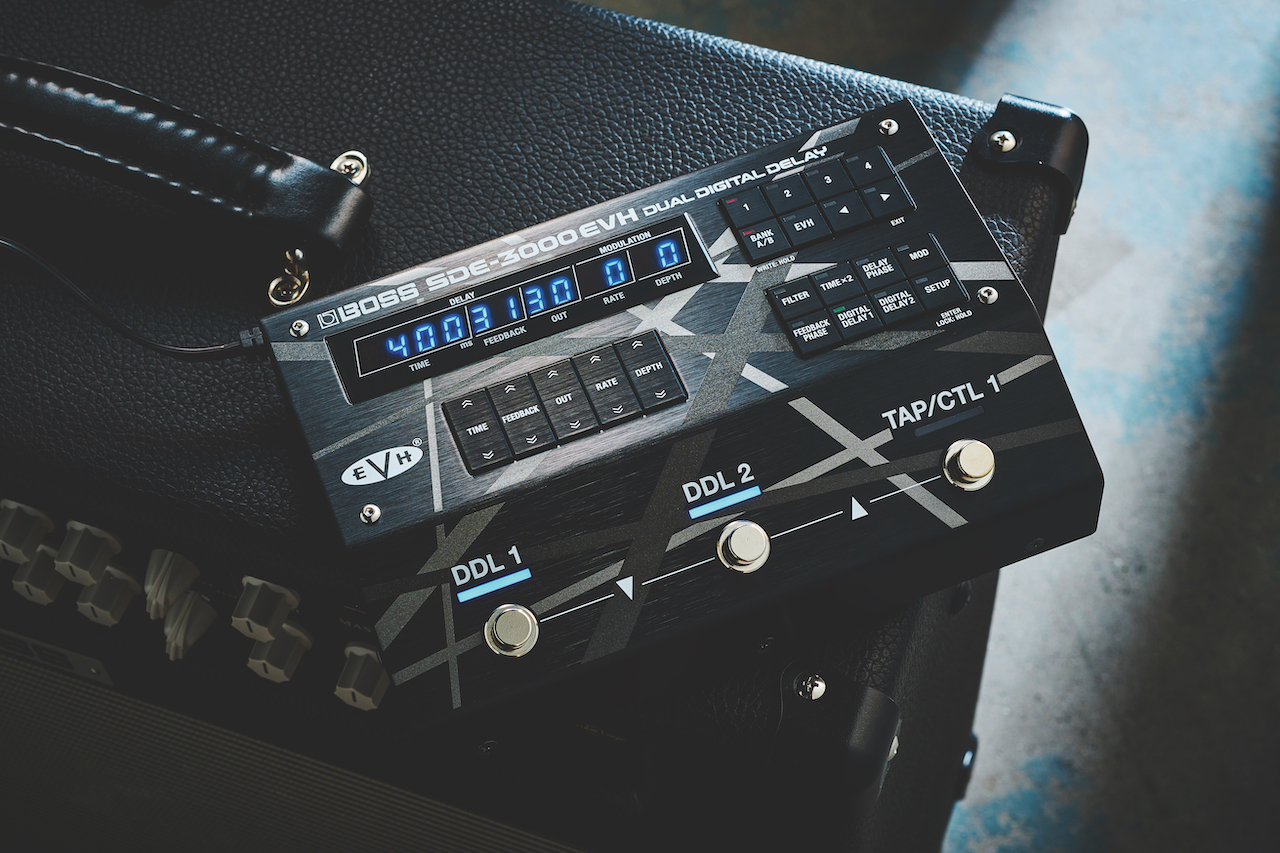“There’s no player of my generation who doesn’t remember when they first heard that almost one-second delayed repeat. It was truly epic”: How BOSS's trailblazing delay pedals changed the world
History repeating: BOSS’s delay pedals changed everything – now the modern range salutes the Japanese firm’s storied past while forging ahead with bold new creations

Imagine a time before the delay pedal. An era when guitarists couldn’t conjure slapbacks or ping-pongs at the click of a footswitch. To anyone who came up during BOSS’s half-century reign, the notion is unthinkable. After all, with today’s range offering everything from next-gen trailblazers like the DD-500 to modern takes on classic units like the Space Echo, Delay Machine, DM-2, DD-3 and SDE-3000, fans of this vital effect have never had such mindblowing tools under their boots.
But delay wasn’t always so accessible or user-friendly. When the original tape echo effect first pricked up ears in the 1940s, it was the preserve of professionals players in top recording studios, and created using bulky mechanical reel-to-reel machines notorious for their expense and impracticality.
Still, for the select few with access to the technology, astonishing sounds were possible. In subsequent years, a run of tape-based delay units rose and fell, from the Echoplex to the Watkins Copicat. But arguably the first to achieve global use was 1974’s RE-201 Space Echo, developed by BOSS’s sister company Roland. Outgoing president Yoshihiro Ikegami started his long career at Roland assembling these units – and they’re still widely saluted as the greatest tape delay of all-time.
Employing a capstan-driven tape format that reduced the mechanical parts, the Space Echo’s branding implied its speciality: unlike simpler rivals, the Roland supplied a widescreen, spacey flavour, sweetened by onboard reverb. As everyone from Hank Marvin to Bob Marley agreed, there was nothing quite like it.
Even so, while the original RE-201 was an industry-standard for studios at the highest level, the original unit’s cost and dimensions were a non-starter for the majority of musicians who plied their trade on the stage. Fortunately, by 1978, the fast-rising BOSS company was ready to pick up that gauntlet, having forged its own identity beyond Roland, and now ready to innovate on its own terms.

That year, BOSS launched its first echo unit in the form of the DM-1 Delay Machine, employing the charge-coupled device (CCD) technology usually associated with cameras and offering flexible analogue delays of up to 500 milliseconds. While the Space Echo remained more capable in outright performance, the Delay Machine eclipsed it for practicality, with the tank-tough metal chassis and on/off footswitch announcing that delay was easily practical as a live effect for the first time. And soon, with BOSS’s early compact stompboxes flying off shelves at the turn of the decade, the company’s ever-curious engineers wondered: could the DM-1’s revolutionary delay capabilities be shrunk further still?
In 1981, the DM-2 answered that question in style. Identified by its magenta chassis, this was BOSS’s first compact analogue delay, now featuring bucket brigade device (BBD) tech – with a huge 4,096 stages – that granted up to 300 milliseconds of delay while making the sound warmer and softer. Just as important, the DM-2’s keen pricing granted access to players at every level. As Robert Keeley of Oklahoma-based Keeley Electronics remembers: “The DM-2 was one of the few affordable analogue delays you could get in the 80s.”
Get The Pick Newsletter
All the latest guitar news, interviews, lessons, reviews, deals and more, direct to your inbox!
Analogue delay would endure – and still has plenty of advocates – but by the early 80s, the digital age was upon us. As with tape echo before it, digital delay was initially the preserve of pro players and high-end studios who could afford rackmount gear like the Roland SDE-3000. Once again, it took a bold move from BOSS to level the playing field, as to the Japanese engineers’ happy surprise they discovered the IC chip from the SDE-3000 would also (just) fit in a compact battery-powered pedal.

As Masao Takahashi of BOSS’s Development Division recalled in The BOSS Book, transitioning into the digital era was a labour of love (“The DD-2 took the longest of any product to develop”). But that original unit in the ongoing DD series drew a line in the sand upon its 1983 release. Not only the world’s first digital delay stomp, but BOSS’s first digital pedal of any kind, the DD-2 was also the foundation for 1986’s even-more-popular DD-3 that lives on in the form of the modern DD-3T.
For those who’d only known analogue delay, that first DD-2 was a revelation, boasting a glassy clarity and vastly increased range that topped out at 800 milliseconds. “You have to include the DD-2 in the list of most influential pedals ever,” says That Pedal Show’s Daniel Steinhardt. “The first-ever digital delay in a compact pedal. There’s no player of my generation who doesn’t remember when they first heard that almost one-second delayed repeat. It was truly epic.”
But the story of delay is an ongoing saga, not a history lesson. Few guitar effects have crossed more generational boundaries, bled into more genres or stayed so relevant in the modern scene, and BOSS’s commitment to innovation – embodied by the motto ‘We design the future’ – is evident in the post-millennial product line.
In 2013, the TE-2 Tera Echo proved a game-changer, powered by the Multi-Dimensional Processing (MDP) whose ambience effect responds to how a player attacks the strings. In 2015, the DD-500 met the demands of the most ambitious music-makers, nailing historic and modern voicings with 12 studio-quality delay modes, while blowing the sonic parameters wide open with constantly evolving system software. “It all ensures the DD-500 ranks among the best high-end delay units available today,” wrote Michael Astley-Brown in Total Guitar.
New blood is essential, but some legends are too good to be consigned to the history books. Since the mid-70s, some of BOSS and Roland’s most storied hardware has burned brightly before falling out of production and into cult status. The original CCD-based Delay Machine was only in production until 1979, for instance, while the first incarnation of the DM-2 lasted just three years before being superseded by 1984’s DM-3.
Since the millennium, however, with the planet’s most skilled designers and engineers at its disposal, BOSS has performed an unprecedented magic trick, bringing back the icons that made its reputation, now bolstered by cutting-edge features that propel this vintage hardware squarely into the 21st century. Power up the modern BOSS Space Echo RE-202, for example, and you’ll detect all the tonal signatures that built the legend in the 70s, from the character-soaked preamp circuit to the unbeatably atmospheric spring reverb (the dead-on tape emulation even factors in motor speed fluctuations).
But this is no museum piece: not only is the reborn pedal-format Space Echo unfailingly reliable on the road, it also ticks contemporary boxes with new features including a doubled delay time, true stereo I/O and a fourth virtual tape head for five more tone combinations.
Likewise, on first inspection of the BOSS DM-101 Delay Machine, you’ll be convinced the clocks have turned back. In reality, this regeneration of the legend pushes analogue delay far beyond what was feasible in the late 70s, with 12 modes delivering every texture of mono and stereo delay imaginable, all created by up to eight internal BBDs, forensically shaped by digital CPU control.
Analogue connoisseurs have also cheered the comeback of the BOSS DM-2, with the iconic magenta stompbox now refreshed as the DM-2w Waza Craft, offering both a faithful reproduction of the original’s warm vintage effect, and the Custom mode that unlocks a cleaner sound and over twice the delay time (800 milliseconds).
For fans of digital delay, meanwhile, this year’s biggest news was the reimagining of Roland’s fabled rack gear of the 80s. Now in a pedal format, the BOSS SDE-3000D nails the inimitable musical character of its namesake, while allowing open-ended modern operation with fully independent delays, flexible internal routing, expanded I/O, MIDI support and 100 memories for storing setups.
Then there’s the stardust of the SDE-3000EVH, with its recreations of the stereo delays that drove Eddie Van Halen’s epic three-cabinet live sound (you’ll even find eight EVH-curated presets bottling the precise settings from the late maestro’s personal delay units).
Times change and technology marches onward, but by reinventing its classic hardware for the modern age – in parallel with brand-new releases – BOSS has defended its crown as history’s greatest exponent of delay. Long may those sonic ripples spread.
This month, Guitarist magazine includes a free supplement dedicated to 50 Years of BOSS. Click here to download it as a digital version or here for a 'digital page-turner' on Issu.
Henry Yates is a freelance journalist who has written about music for titles including The Guardian, Telegraph, NME, Classic Rock, Guitarist, Total Guitar and Metal Hammer. He is the author of Walter Trout's official biography, Rescued From Reality, a talking head on Times Radio and an interviewer who has spoken to Brian May, Jimmy Page, Ozzy Osbourne, Ronnie Wood, Dave Grohl and many more. As a guitarist with three decades' experience, he mostly plays a Fender Telecaster and Gibson Les Paul.
“Our answer to everything players have asked for and more”: Neural DSP’s Nano Cortex had one major drawback – but now it’s been addressed with a huge free firmware update that takes on Kemper and TONEX
"The ability to use this as a midweight MIDI brain for a gigging setup is what makes it unique.": Walrus Audio Canvas Clock review



![[from left] George Harrison with his Gretsch Country Gentleman, Norman Harris of Norman's Rare Guitars holds a gold-top Les Paul, John Fogerty with his legendary 1969 Rickenbacker](https://cdn.mos.cms.futurecdn.net/TuH3nuhn9etqjdn5sy4ntW.jpg)







